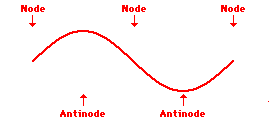Background
What Is Cymatics And How Does It Work?
Cymatics is the study of sound and vibrations. It focuses on the visualization of sound (journey of curiosity). Standing waves are what make experimentation in cymatics possible. A standing wave occurs when two waves, of the same frequency and altitude, moving in opposite directions, combine to create one wave that doesn’t appear to be moving in any direction.
https://www.jewishmalibu.com/templates/articlecco_cdo/aid/3285339/jewish/dpfrequencycom-dpf-dpfrequency.htm
The two waves are composed of an incident wave and a reflective wave, meaning a singular wave that hits a surface and is reflected back onto itself. These are the two waves that, at the right frequency, interfere with each other to create a standing wave. The standing wave is composed of nodes and antinodes. Nodes are points in the standing wave where there is no motion. Antinodes are the points in the wave where lots of motion is occurring.
https://www.physicsclassroom.com/class/waves/Lesson-4/Harmonics-and-Patterns
Materials respond to distinct frequencies to create standing waves. These frequencies are called harmonic frequencies. The standing waves are what allow sound waves to be captured in a visual format. They allow us to “see” sound.


Important Contributors To Cymatics
Named the “father of cymatics,” Hans jenny was the first person to popularize cymatics. Born 1904 in Basel Switzerland, Jenny, though a talented musician, instead chose to become a physician. With his book, published in 1967, titled Kymatic Volume 1, Jenny introduced the world to modern cymatics. He mostly experimented with tone generators and crystal oscillators so that he could control both the frequency and amplitude being played. He believed that cymatics play an important role in the creation of the universe and that it describes many of the patterns in nature.


Though Chladni is most recognized for the creation of chladni figures and the experimentation with chladni plates, he was recreating Hooke’s experiments. Hooke had experimented with running a bow along the side of a glass plate that had been covered with a thin layer of flour. He noticed the symmetrical patterns that formed on the plate. Though Hooke is more widely known for his law on elasticity.
Chladni used Hooke’s experiments with a bow and glass plate as a base for his experimentation in cymatics. He used a bow and a brass plate sprinkled with sand for his experimentation. The patterns he noticed on the plates were named Chladni figures. He receives the recognition of this experiment because of his book, Discoveries in the Theory of Sound published 1787.



Mary D. Waller was a professor of physics at the Royal Free Hospital Medical School in London. She recreated Chladni’s experiments and took note of the patterns that she found at certain frequencies. She also developed the mathematics behind these experiments. She published her research in a book titled, Chladni Figures, a Study in Symmetry (Journeyofcuriosity.net).